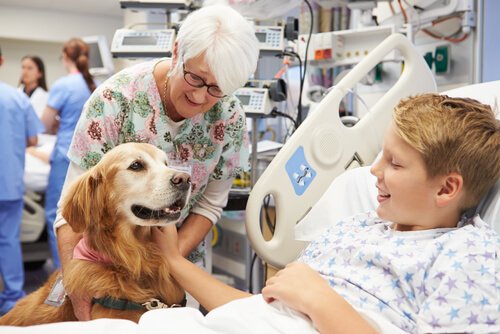Animal-assisted Therapy Works


Written and verified by the lawyer Francisco María García
Animal-assisted therapy consists of using certain types of animal in therapy, rehabilitation, integration, or child psychology.
Animal-assisted therapy rejects all and any kind of emotional or physical abuse towards the animal. All animals in this kind of field are raised, cared for, and given the respect they deserve. They enjoy their job as therapy animals as much patients enjoy being with them.
Does Animal-assisted Therapy Work?
For many years, these therapeutic practices were considered to be alternative and were questioned by medical professionals. However, advances in the medical research now recognize that patients scientifically benefits from animal-assisted therapy.
Nowadays, medical professionals highly recommend animal-assisted therapy, as well as the exercises and interaction with each animal. Continue reading to find out about some of the applications and benefits of every kind of modern animal-assisted therapy.
What animals are used?
Advances in animal-assisted therapy studies and techniques are now using many different animals. The animal that are used depend on the aim of the therapy and the preferences and health of each patient, child, baby, etc.
Dogs
Obviously, man’s best friend couldn’t be absent from this list. These animals have countless uses for therapy, integration, and child psychology.

eople with a partial or whole loss of sight or hearing use guide dogs because these animals provide them freedom and help them in social interaction. They’re part of the routine and give people access to a more active and healthy lifestyle.
Dogs are also having great success in child and educational psychology. They’re useful for encouraging learning and socialization in children and teenagers who have developmental disorders, such as autism or Down’s syndrome.
Dogs also play an important role for patients in critical conditions or with terminal illnesses. You’ll also find them in geriatric wards and old-folks-homes. Just their presence is enough to improve everyone’s mood and make them feel relaxed.
Dolphins
Dolphin-assisted Therapy, DAT, is good for producing both hope and controversy. Many studies demonstrate that interaction with these beautiful creatures has important health benefits, and the majority of patients acknowledge its effectiveness.
The controversy arises due to the way they raise the dolphins. Is it really ethical to take an animal out of his natural habitat to benefit our health?
However, there are organizations like the Israeli Dolphin Reef raise “therapy dolphins” in open environments in the Red Sea. This way, they can train them without deprive them from their instincts and natural routines, which in turns guarantees a better quality of life for these animals.
Horses
Classical civilizations already knew about the benefits of equine-assisted therapy. For example, in Ancient Greece horses used to prevent and treat multiple physical and psychological disorders.

Currently, specialist use horses to rehabilitate children, teenagers, and adults with psychological, neuromuscular, cognitive, and social issues.
Cats
Recent studies have shown that contact with a cat’s fur can stimulate memory and cognitive ability in the elderly. Therefore, cats are very common in animal-assisted therapy for the elderly. Cats tend to the be their preferred animal due to their friendly nature and beautiful fur.
Small Lizards or Iguanas
Using lizards is certainly one of the more exotic and innovative ideas in animal-assisted therapy. These small reptiles are capable of stimulating cognitive, emotional, and social abilities in children. They also have one great advantage: they have no fur. As a result, they’re perfect for children with allergies or respiratory problems.
Rabbits, Hamsters, and Guinea Pigs
Finally, we couldn’t leave out these little rodents. These animals are good for sentimental and social stimulation for children.
It’s important to mention that only specialist can practice animal-assisted therapy in any form. Each patient needs to receive personalized attention and treatment, therefore it’s important to choose the right animal, activities and timetable.
Animal-assisted therapy consists of using certain types of animal in therapy, rehabilitation, integration, or child psychology.
Animal-assisted therapy rejects all and any kind of emotional or physical abuse towards the animal. All animals in this kind of field are raised, cared for, and given the respect they deserve. They enjoy their job as therapy animals as much patients enjoy being with them.
Does Animal-assisted Therapy Work?
For many years, these therapeutic practices were considered to be alternative and were questioned by medical professionals. However, advances in the medical research now recognize that patients scientifically benefits from animal-assisted therapy.
Nowadays, medical professionals highly recommend animal-assisted therapy, as well as the exercises and interaction with each animal. Continue reading to find out about some of the applications and benefits of every kind of modern animal-assisted therapy.
What animals are used?
Advances in animal-assisted therapy studies and techniques are now using many different animals. The animal that are used depend on the aim of the therapy and the preferences and health of each patient, child, baby, etc.
Dogs
Obviously, man’s best friend couldn’t be absent from this list. These animals have countless uses for therapy, integration, and child psychology.

eople with a partial or whole loss of sight or hearing use guide dogs because these animals provide them freedom and help them in social interaction. They’re part of the routine and give people access to a more active and healthy lifestyle.
Dogs are also having great success in child and educational psychology. They’re useful for encouraging learning and socialization in children and teenagers who have developmental disorders, such as autism or Down’s syndrome.
Dogs also play an important role for patients in critical conditions or with terminal illnesses. You’ll also find them in geriatric wards and old-folks-homes. Just their presence is enough to improve everyone’s mood and make them feel relaxed.
Dolphins
Dolphin-assisted Therapy, DAT, is good for producing both hope and controversy. Many studies demonstrate that interaction with these beautiful creatures has important health benefits, and the majority of patients acknowledge its effectiveness.
The controversy arises due to the way they raise the dolphins. Is it really ethical to take an animal out of his natural habitat to benefit our health?
However, there are organizations like the Israeli Dolphin Reef raise “therapy dolphins” in open environments in the Red Sea. This way, they can train them without deprive them from their instincts and natural routines, which in turns guarantees a better quality of life for these animals.
Horses
Classical civilizations already knew about the benefits of equine-assisted therapy. For example, in Ancient Greece horses used to prevent and treat multiple physical and psychological disorders.

Currently, specialist use horses to rehabilitate children, teenagers, and adults with psychological, neuromuscular, cognitive, and social issues.
Cats
Recent studies have shown that contact with a cat’s fur can stimulate memory and cognitive ability in the elderly. Therefore, cats are very common in animal-assisted therapy for the elderly. Cats tend to the be their preferred animal due to their friendly nature and beautiful fur.
Small Lizards or Iguanas
Using lizards is certainly one of the more exotic and innovative ideas in animal-assisted therapy. These small reptiles are capable of stimulating cognitive, emotional, and social abilities in children. They also have one great advantage: they have no fur. As a result, they’re perfect for children with allergies or respiratory problems.
Rabbits, Hamsters, and Guinea Pigs
Finally, we couldn’t leave out these little rodents. These animals are good for sentimental and social stimulation for children.
It’s important to mention that only specialist can practice animal-assisted therapy in any form. Each patient needs to receive personalized attention and treatment, therefore it’s important to choose the right animal, activities and timetable.
This text is provided for informational purposes only and does not replace consultation with a professional. If in doubt, consult your specialist.








